Techniques Often Used In Games:
There are many techniques often used in games, because of their effectiveness. Though I would tweak a few of these for my games, so it is not conforming with the regular structure of games so much, they are nice features to include, and good fillers for the gameplay. Many are used very often, such as a preparation of a battle offering the player much more arsenal and power for the upcoming hardships. Others such as time limits added, aren't as much. These techniques can be seen as literary devices of games or such.
Preparing For A Battle:
Often in games, when larger battles are in store. The game starts being more generous in giving of health, ammo, weaponry, lives, ect... You can then assume that the upcoming enemies will be harder, and there will be more.
Being Powerless:
Often in games the player's weapons will be taken from him/her, then adding a weak feeling to the player. Running around enemy activity powerless is a very powerful effect in a game.
Mass Effect 2: When the ship is commandeered, and the player plays as Joker, who can barely run, and doesn't have a weapon.
Chase Scenes:
Being chased without any weapons or with low ammo is sometimes used (usually survival horror, thriller games), making it more fast paced and thrilling. They can be on foot or in vehicles, L.A. noire uses many chases scenes, as the video shows below. (Language in video)
Being Powerful:
Another technique used is when the game gives the player extreme power, running through enemies very easily, for a short period of time, often occurring after a plot twist.
Examples:
Splinter Cell Conviction: Given unlimited Mark and Execute after finding out about his daughter.
Gears of War 2: Given control of Brumak (a huge creature, that is usually an enemy), able to run through hundreds of enemies extremely quick.
Alan Wake: Concert with large amounts of ammo and supplies accompanied by a friend, and with large amounts of music going on.
A Long Wait:
A classic game technique example, used countless times. When a slow gate, elevator, computer being hacked, or a door being unlocked is going on, the main character is stuck defending the area, either protecting an A.I. doing something, or just waiting for the action to finish. Sometimes timers are even used.
Borderlands, Zombie Island: Elevator, the antagonist pointing out this constantly used game technique for one, by having a hand cranked elevator, and flat out saying "Don't act like you've never had to wait on a hand cranked elevator during a zombie outbreak before jeese."
Left 4 Dead 1 and 2: Both games use many of the "long wait" method.
Halo 1, The Library: While following guilty spark, guilty spark has you waiting and defending while he is hacking a door open.
Resident Evil 5: A computer is being hacked by "Josh Stone", and you must defend him while he does so.
Time Limit:
Timers are sometimes used to rush the player, either a final boss, a race to an area or something completely different. Often things are exploding and resulting in a larger explosion.
Examples:
Halo 1,3, Race to Finish: 1st on Warthog to escape the flood, second to leave the planet, both very similar, because they worked so well.
Mass Effect 1,2: Small timers used. Mass Effect 1, to get to Tali before she is killed or lost, and Mass Effect 2 to get off of a ship that is self destructing.
Defending An Area:
Defending of an area is often combined with "A Long Wait", but sometimes the player is just defending an area for a set amount of time, large amount of enemies ect...
Obtaining A Vehicle:
Obtaining a vehicle is often a way to expand the environments to the game. Giving the player freedom and the feeling and desire of exploration.
Borderlands: Gives the player a vehicle fairly shortly in the game.
Halo 1, Halo: The second level gives the player a warthog, fairly shortly after the beginning of the level, and this level is at least one of the largest and memorable, because of the allowed exploration.

Switching Up Gameplay:
On Rail Shooting
Vehicle Section
Platforming Section
Changing Camera Angles
Stealth Sections
Puzzles, Challenges,
Different Game Modes
Multiplayer
Examples:
Resident Evil 5: After much 3rd person playing, the game starts a vehicle section with the player being on a turret for an on rail section.
Resident Evil 5: Actually right after the on rail section, an actual vehicle section begins, with the player driving a boat through marshes.
Resident Evil 4/5: Many puzzels are introduced in the Resident Evil games I've played, some are fairly simple, others will take a long time, and they have impact on the story.
Assassin's Creed 2: Wagon section, where the player is on a rough wagon ride to a city.
Assassin's Creed Revelations: Assassin's Creed tried a couple of new game modes, den defense and Desmond's puzzle sections, they didn't particularly work very well, but they were trying to vary the gameplay.
Multiplayer: Multiplayer obviously is in a million games, but sometimes after a series has been going on, the next game offers multiplayer, games like Assassin's Creed Brotherhood and Revelations, and Mass Effect 3 are to have multiplayer.
Bosses:
Bosses are something that have always been used in games. Sometimes they are simply are the antagonist, some are major enemies in the story, but at other times, they can just be tougher enemies. Bosses add variety to the normal gameplay, as they usually require different strategies to get past. Also, they are usually just crazier, cooler, or can just be larger in size. Often they are the ending of a game. These are obviously used in countless games.
Challenges, Achievements, Trophies:
Challenges and achievements add to the replay value of a game, with many random things to do, the player has something else to try to achieve. Challenges are very well implemented in RPG's as Borderlands used it, because it tracks the statistics, it rewards you, and allows for variety in the way of playing.
Customization:
Customization of a character is very important to any RPG, it makes the player feel closer to the character, and adds a whole enjoyable level of being able to change the appearance of the character. Often the customizing of a character changes the statistics of the player's character, but when the equipment has no effect, the player is not constricted to having clothing/armor that is always for higher levels. But finding a more powerful piece of equipment is always rewarding, so it really depends on the approach that the game wants to make. Appearance isn't the only thing that is customizable in games, but it is the most often used. Sometimes it is powers, weapons, or stats of the player.


Here is an example of the many things Fable changes the appearance of your character.


Easter Eggs:
Easter eggs are hidden things in games, mainly in reference to something else. Each Halo game has had numerous easter eggs, when added, they allow for secret interesting areas or funny references. They can also cause popularity in a game, if they are good enough. Because when found they are often put onto Youtube, and people want to find them for themselves. They sometimes even spoil some of the next games details.
Total Freedom:
Total freedom is when, after the introduction of a game, the player is opened up to a huge environment. Games like Fallout, Elder Scrolls, Rockstar Games, and Mass Effect slightly use this method. Fallout and Elder Scrolls always have about a 30 minute introduction to the game, and they are thrown into the world. Fallout 3 used the vault to constrict the player in the beginning, the player then escapes and is able to explore. Oblivion had the player in jail, then escapes, and is opened up to the world. Very similar methods. While Mass Effect, a more linear RPG, has a much longer introduction, about an hour and a half (at least the first playthrough), before allowing the player to explore, though the exploration is limited, only being able to do micro side missions. Some areas are blocked off, but in most cases the whole world/universe is open.
Progressing Freedom:
Progressing freedom is when, the game's world is slowly opened up after major story events. Fable has used this method for each game. After the introduction, the player emerges into another area, given a task, and eventually that leads to another area, but still having the past area open for exploration. This continues until the large world is fully open for exploration. This is not used as much in RPG's, but it does have its effect. It allows for more exploring of an area before quickly leaving to the next, it rewards players for doing the story or major side quests by allowing them with a larger area, and it simply a different approach on the world. For example, Fable 1 starts you off as a kid, doing small tasks, then a twist in the story occurs, the player is taken to the Heroes Guild, the player does more story oriented quests in the guild, still small tasks, then the player is opened up to the outside of the guild, to a few small regions, then another couple missions, and a few more regions open up, this process continues until the entire world is open. And during the process of the world opening up to the player, more side missions are available to the player, again rewarding the player for the world's new regions.
Hubs:
Hubs are places where the player spends a large amount of time, where they get their missions, navigate around the world, get missions or quests, buy equipment, save the game, or many other things. For example in Mass Effect, the Normandy(the ship used in the game) is the hub. It is where Commander Shepard (the protagonist) spends a great deal of time, because it is where he/she navigates around the world using a galaxy map, buys equipment (Mass Effect 1), communicates with squad members, and is simply a safe place. 2), Hubs add a homey feel to an area, where the player feels safe and familiar with it, Fable 1 used the Heroes Guild, Dragon Age: Origins used a campsite, The Elder Scrolls used Cloud Ruler Temple, and the list goes on. They are usually in RPGs, but they can be used in all sorts of games. The indie game Miner Dig Deep, uses a simple hub, with a small store, a save area, and the entrance to the mine which is where the game's activity is. Hubs are very good ways to get the player to feel like there is a safe place, but it can also be used against them, for example in Fable 1, the Heroes Guild is destroyed, and in Mass Effect 2, the ship is commandeered, making it feel like you lost your safe haven.
Leveling Up:
Leveling up is another RPG element, though it is now more often used in other genres. Leveling up can be as simple as going from level 1 to 2, and having skills boosted in efficiency. But, they can also be very deep, choosing what you level up, and what kind of character the player will want to create. Fable uses a different method, gathering experience points in three main categories, Strength, Skill, and Will. The more the player uses each one of these combat methods, the more experience gained in that category. But with each kill, the player receives general experience, which can be used to upgrade any skill, while the others must remain in their own subject. Fable 3 did a new way of leveling up, rather than going to a menu or something after leveling up. The player goes to the "Road to Rule". This path includes treasure chests which require guild seals from combat or quests, these treasure chests will have upgrades to magic, guns, or melle. The player must advance in the main story to go past gates, separating higher level upgrades. At the end of the road is the castle, which is where the player is aiming for (he/she is trying to be king/queen).
http://fable.wikia.com/wiki/Road_to_Rule
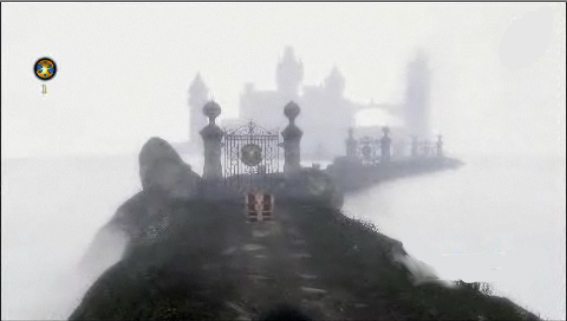
The latest Bethesda RPGs, Fallout and Skyrim, have added "Perks". Every time the character levels up, the player gets to choose a perk. These can be a variety of things, doing more damage with a type of guns, opening unique dialogue, getting 10% more xp every time it is awarded, and many more. This perk picking is very effective to make leveling up a very desirable thing.

Trivial Tasks:
Obviously these are also done in many RPG's for quests, like go find me 10 blueberry pies that can only be dropped by this creature. But also they are used for other methods. Often in games, while on the way to go do a more important mission, something blocks the way. Such as in Batman: Arkham City, while on the way to go find Penguin, the main way inside is blocked by an electrical feild that can't be hacked like most ones can. The player must go and find several signal jammers before fighting Penguin. And then... after much work to get to Penguin, the player must do another trivial task to go get Mr. Freezes suit. Sometimes these trivial tasks can be used for plot twists, the player is distracted by some menial task, and then comes back to see that a player has been killed/captured/ or whatever.
Scores, High Scores:
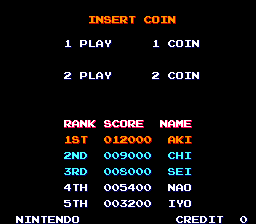
Scores add a way for the player to challenge his/her self or others. They track a certain number of points that the player has gotten for doing certain tasks, such as collecting items, getting a fast time, or defeating enemies. They can be extremely competitive and combined with leaderboards, or they can be casual, just so the player has something to beat. Many games start off a high score list with a pre-made set of scores for the player to beat. Scores are often something to cause competition in something like an arcade game like Pacman or Galaga.
Maps, Ways to Access Game:
There have been several ways games have created menus or things to navigate the world of a game. Some games simply use maps, like Elder Scrolls, some games use a hub, some just use menus, some use a mario like system where the player is going to a next point on the map each level, (Ms. Splosion Man Also Used This, Inspired by Mario) and there are many others. Fable had a very interesting way of going about the map system, Lionhead studios created a 3D map, much like Skyrim's, but this one you could interact with, you could see important characters walking around towns, buy and sell property, as well as simply fast traveling. Mass Effect has been using a galaxy map in the center of the hub, which can access nearly any point in the game world. Here are a few examples of the ways games have their maps set up:
Shadow Complex, Metroid Style Map:

Metroid Map:

Overworld Map:

Mass Effect:

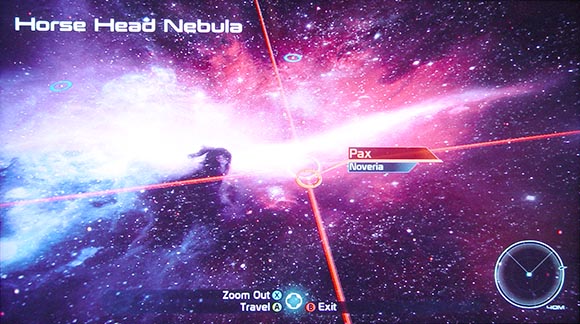
Mario Inspired Ms. Splosion Man:

Fable 3:
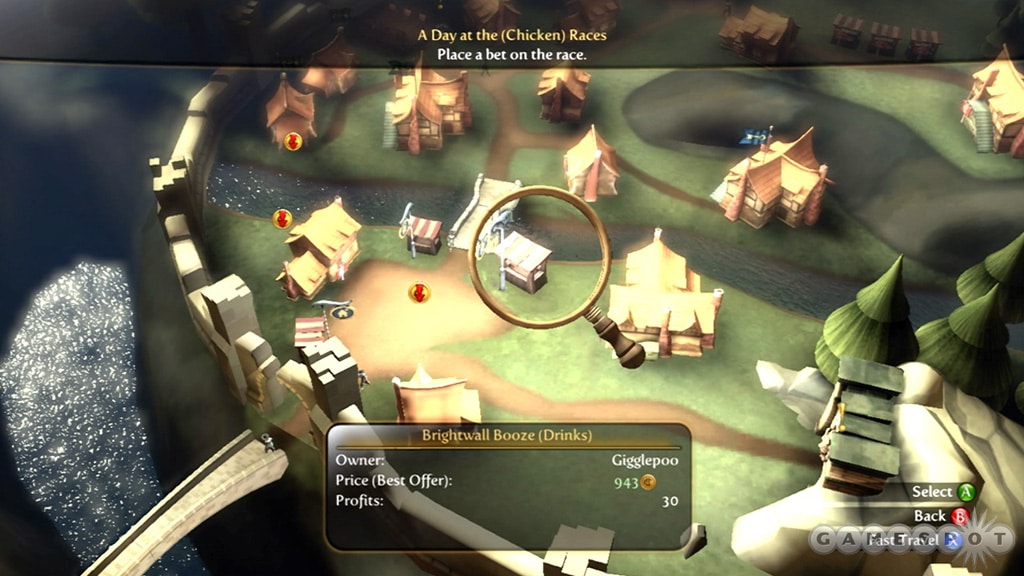

Elder Scrolls:


Mini Maps, Motion Trackers, ect...
Mini Maps are often a key part to a game's HUD, giving the player a simple way to see key things in a game. Whether it shows enemies, shops, important people in the story, quest/mission givers or any number of things. Mini Maps are a simplified version of going to a pause menu and looking at a map. First Person Shooters don't go much farther with their mini maps, they usually use motion trackers, or similarly named things. It focuses on enemies and teammates. Here are some examples of mini maps:
Fable, Top Right Corner:

Grand Theft Auto, RockStar Style Minimaps:
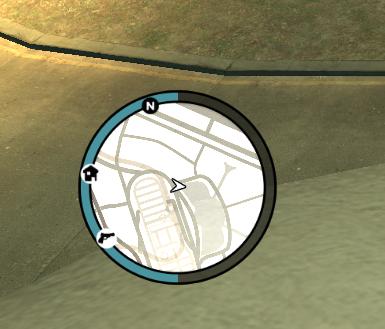
MineCraft:

Halo, Bottom Left Corner(4):

Inventory Screens, Pause Menus
Several different ways are done for pause menus and inventory screens as well. As I have done many times within this post, I will mention Elder Scrolls games, Fable, Mass Effect, and a few others, as I feel each of these games have solid unique ways to go about this. Keep in mind these are all RPG's except the "others" as I mentioned. Elder Scrolls Oblivion, went about the inventory simply, showing a scroll, tattered paper as the inventory screen, with small icons representing the items, with the player on the side. Elder Scrolls Skyrim went for a cleaner way, they scrapped the character on the side, they created a four directional screen accessing map, inventory, skills, and magic. This worked well, but got rid of much of the style that was in Oblivion in my opinion. Fable 1 and 2 both had fairly simple inventory systems, breaking it down into categories as Elder Scrolls games do, and showing just a list of items. Fallout 3 used the "pipboy", which is on the characters wrist for a menu, this adds a cool feel as you bring up your arm to access your inventory and quests. Fable 3, did away with nearly all menus, and with the pause screen, they created the "sanctuary", a host of different rooms, one holding your clothing, one your "arms" (armory), one holding all your gold and finical business, and one holding online and multiplayer related things. With the map, options, and saving in the introduction room, which is the base of the sanctuary, which can access all the other rooms, they can also be quickly accessed by the D-Pad. Many probably disagreed with this unique way of going about avoiding menus, but I felt it was a fresh very interesting approach to pause menus and such, and it was a much more visual experience. Both Mass Effect games have used a efficient circular pause menu, where the analog stick can easily reach anything at any time, things such as "squad", "codex", "journal", and "options" are held here. Many games go about a simple, fairly efficient pause menu, but if style is used, it can be highly appreciated, like I am right now. Here are screenshots of different pause menus.
Fable 3:


Mass Effect 1 and 2:

Fallout 3:


Oblivion:
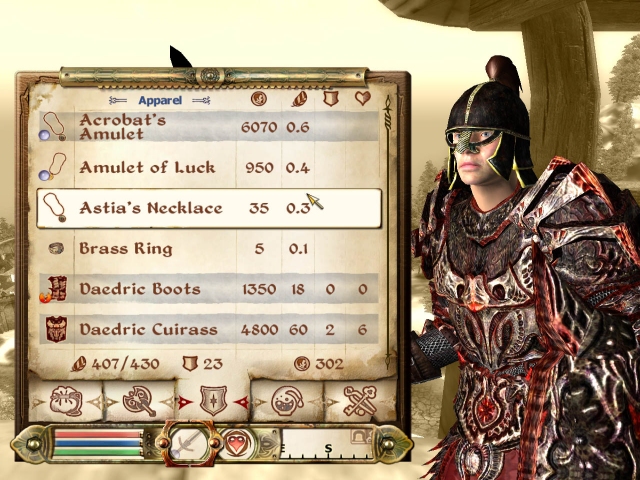

Skyrim:
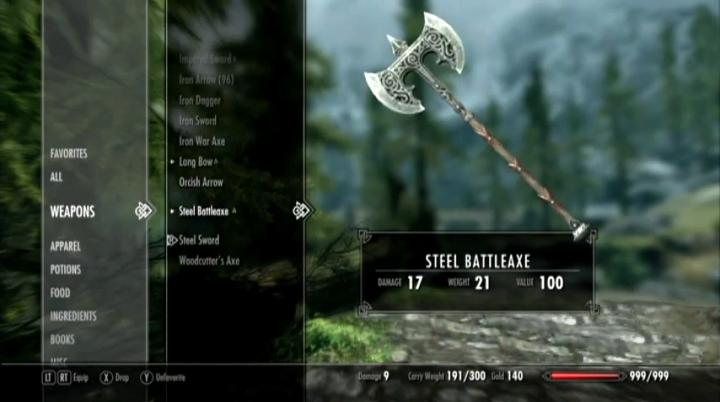

Weapon Selection Menus:


Color Schemes
After playing many games, I've noticed that many games seem to stick with certain color schemes. I especially noticed this after playing Mass Effect 1, and switching to Mass Effect 2, when the blue main menu, style, and even pause menu were all changed to orange. Even the covers of the game changed color palettes. I suspect after what I've seen that Mass Effect 3 will be a red based color scheme for menus, or other things, but I could be wrong. I also noticed that kind of switch from Fallout 3 to Fallout: New Vegas. The Fallout 3 HUD, main menu, cover, draw distance fog even were all switched from green to an amber like color in Fallout: New Vegas. Deus Ex Human Revolution is a great example of color schemes, as the entire game has a dark orange like tint to it. This is a technique that can be good if executed correctly, it can give off a certain feeling to a game, based on the color chosen. Here are some examples:
Deus Ex: Human Revolution



Mass Effect 1:
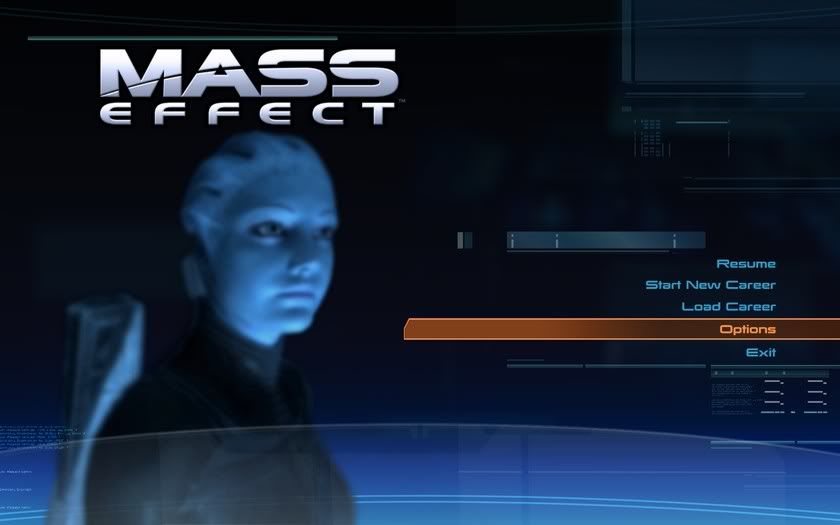

Mass Effect 2:
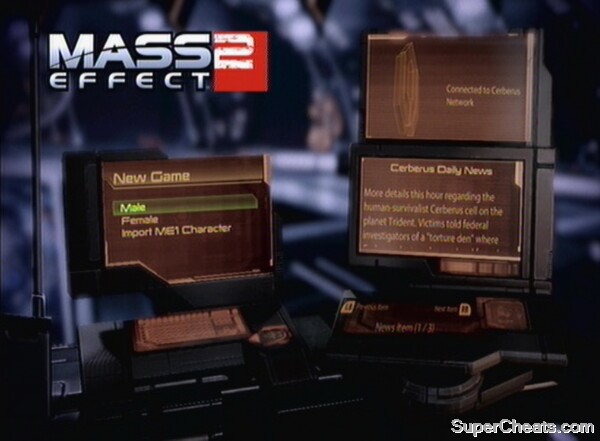

Fallout 3:


Fallout: New Vegas:

.jpg)
Choices/ Morality/ Good and Evil Choices:
Many games, usually RPG games, offer choices of morality, mainly good or evil choices that are obvious, but choices are presented. The fable series heavily focuses on morality as part of the creation of your character. Fable 1 in particular. The fables actually physically changed your character based on choices you've made. If you were evil, you would grow horns and a dark aura around your character, if you were good, you would gain a halo, butterflies around your character, and a bright presence. Fable 2 and 3 continued this, Fable 3 had an interesting approach in a game though, because you become king or queen, you must keep your promises you've made to get to your position. But with a coming threat, the kingdom needs money, and to supply itself for a battle. So you can keep your promises, but be ill prepared for battle, resulting in death, or be seen as a malevolent king/queen that will keep the kingdom safer. Fallout and several other games have done this. In Fallout 3, a town Megaton could be blown up by an inactive warhead in the middle of the town. Doing so will gain you money, but lose a valuable town and Karma.

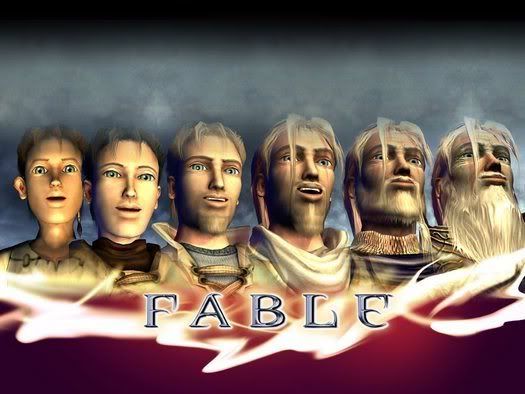


The Mass Effect series has also focused itself of choice, between "Paragon", and "Renegade", not always in good and evil though. Perhaps the biggest part of Mass Effect is it's dialogue, the player chooses everything that "Shepard" will say. This mainly boils down to good, neutral, or bad things to say, but depending on the choice, the outcome may be different to the ending of the Mass Effect lore. Mass Effect has created a unique and powerful addition that allowed a huge amount of choices to be carried over from Mass Effect 1 to the second game. This will continue to Mass Effect 3. This added a true weight to the players decisions, choices would continue through the universe through each game. Mass Effect 2 also added physical change to the character when good or evil. The player starts out with facial scars from an operation. If the player is benevolent throughout the game, the scars will go away faster than would if he/she was neutral. If the player does evil acts, the scars will worsen. Mass Effect used "Charm" and "Intimidate" to create a more powerful way of handling situations. Charm would obviously be the "good" way to deal with something, and "Intimidate" would be the "bad" way to handle it. Often ending in the same kind of situation, dealing with the problem non violently, pushing someone for information or other things. Mass Effect 2 expanded upon this with an interrupt feature, which would actually intervene with someone talking, or some situation. A paragon action might be saying something extra to someone who may have started to cry, a renegade action may just be shooting someone who seems they might pull something, or just dealing with something more violently than may have been necessary.
Here is (fairly humorous, if you slightly like "dark humor", othertimes, "Shepard" is truly being a jerk) a video that shows the more evil choices that can be done:
Here are paragon examples:
In most cases, these games will still have the player saving the world/universe/kingdom, but the choices will shape how the character did such a thing, like Mass Effect's "Renegade", the player will have a "whatever it takes" or "the ends justify the means" attitude. Choice in games gives the player an even deeper feeling of being or shaping the character. If anything, they add much replay value, offering several branches of how situations can go.

Loadouts in Multiplayer

In games with multiplayer, the way of selecting weapons or powers is sometime done by "loadouts". The example above is from Halo Reach, this shows up after spawning and the beginning of the match or round in multiplayer. These work well to switch the character's play style in game.
Classes
Classes are used in multiplayer often. They are a simple way to offer the player with choices on how combat will differ and how the player will "play". Many games like Brink, Monday Night Combat, Battlefield, Mass Effect 3, and many others do this. The main three for fantasy games are mages, warriors, and archers. Games with guns usually have medics, close quarters fighters, snipers, medium range, and tank like characters Here are a couple of examples:
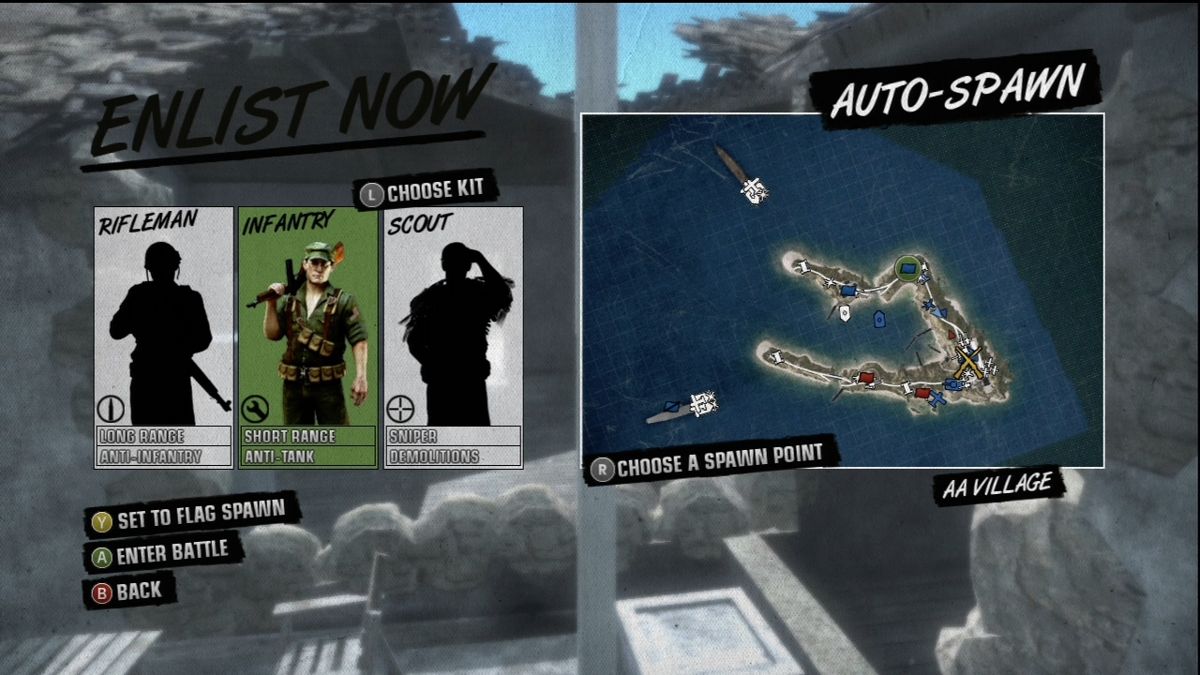
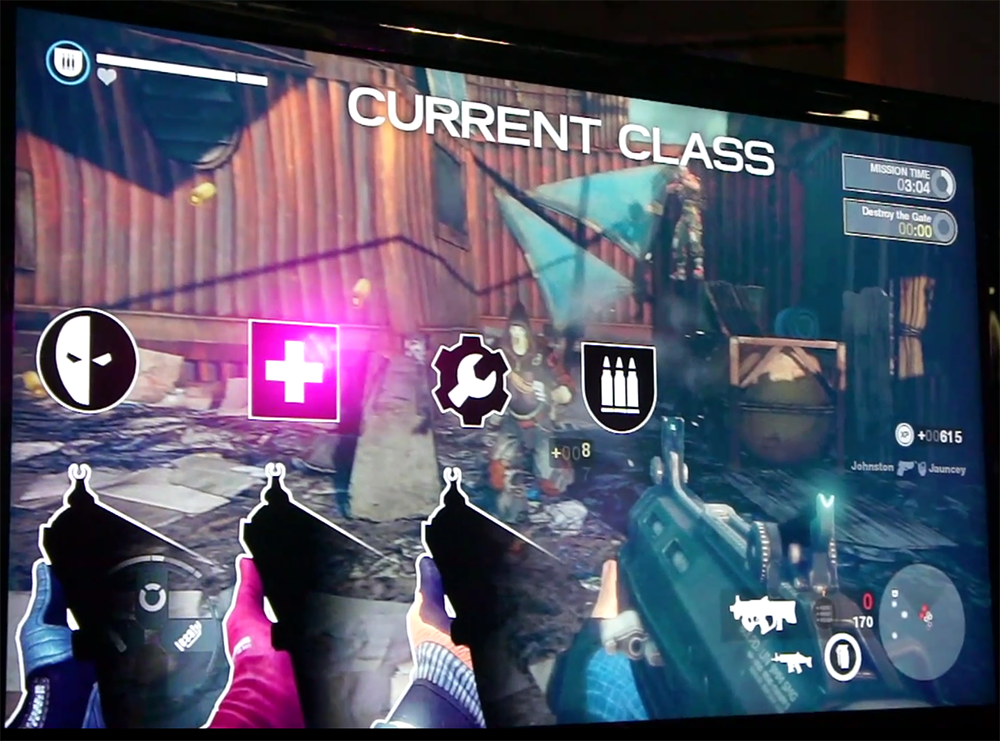



In Game Map Makers
In game map makers are powerful ways to allow players to be creative and have much replay value. Games that offer map making or at least customizing will usually be over run with strange and creative things. Such as forge art in Halo 3 and Reach. Minecraft and other similar games like CastleMiner, Total Miner Forge, all have a unique way of going about this, putting the player in a sandbox like world where they are encouraged to build structures to protect themselves. Map makers can allow for prolonged popularity of a game, instead of there only being 11 multiplayer maps in a game, there's suddenly thousands. Here are some examples of games with map makers:
Halo:



MineCraft:



Farcry:
In Game Upgrades
In game upgrades add a strategic way to implement upgrades that can be maximized through a single round or short period of time in a game. Monday Night Combat makes a perfect example of this. Players gain money for defeating robots and other players, and the player can upgrade three powers and a constant effect, like health, damage, or a weapon upgrade. Here is a picture showing an example:
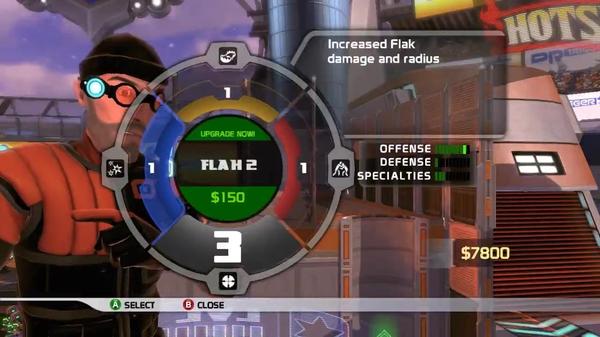
New Game +, Importing Second Play-through
Campaign + or similar kinds of additions in game add much to a game's replay value. Many games have an option where you can import your character's XP, upgrades, items, or similar things that you've collected through out the game, into a second play-through. This allows the game to be more challenging the second time around, which can be as simple as making enemies have more health, or it can be more complex. Such as in Batman: Arkham City, in a usual campaign, counter icons pop up when an opponent is about to attack, in campaign +, they won't which adds a challenge to the combat. You also will keep all your gadgets and upgrades which you spent all of the first play-through collecting, which will allow for a Metroid style gameplay, going back to areas which previously were blocked off due to not having an upgrade/tool... These are usually done in R.P.G. like games, but they are not excluded to such genres.
Campaign Scoring
Campaign scoring is a great way to add challenge and more of an arcade feel to what can be a serious game. It simply adds a score that is tracked by killing enemies, progressing through the levels, ect. These often include modifiers to the game's difficulty and change how certain parts of the gameplay works. Halo Reach Halo 3, and Gears of War 3 are all large retail games that have implemented this feature. In Halo there are silver and gold skulls. Silver skulls change things without affecting the[youtube][/youtube] score multiplier, adding things like larger explosion radiai, unique dialogue, and other things. Gold skulls add a multiplier to the game, which make enimies have more armor, stronger shields, dodge grenades/bullets much easier, no checkpoints, half ammo dropped from enemies, no minimap, no motion sensors, no HUD, ect... So campaign scoring is an addition that makes the story much more appealing for an arcade feel, it makes multiplayer more enjoyable with the score.
Quicktime Events
Another technique used in games are "quicktime events". This technique is fairly recent, it was first introduced in Shenmu. These events provide a cinematic feel while still having the player involved in the game. Several games now use them, they are often used for finishing moves in games like The Force Unleashed I and II, God of War, Enslaved: Odyssey To The West, and many others. Quicktime events should not be overused though… In many games they lose their power from the same finishing move or just getting tired of them from repetition.
Shenmu, First Quicktime Events In Games
The Force Unleashed Quicktime Event
Random Spawning
Another technique is to have random spawning locations of enemies. This keeps the player more interested when replaying the same level; keeping the player uncertain where enemies are coming from. Games like Left 4 Dead have done this, it's an especially useful technique for survival horror games as the player shouldn't be expecting where/when a surprise comes.
Multiple Lines of Dialogue
Adding to preventing repetive-ness is another simple technique of having multiple lines of dialogue. This obviously can be done a lot or it can just be put into key areas. For example, if there is a very difficult area where the player may be dying very often and there is a NonPlayerCharacter saying something like "They're Everywhere!", that will get very annoying after dying 3 times. But multiple lines can be used, randomly chosen upon spawn. Now the NPC can say "Look Out! They're Everywhere!", "We're Surrounded, Defend Yourself!" and "They're Everywhere!". It's a small effect I've noticed is worth adding. Or, I've noticed that some games simply don't have the dialogue play after the first time it is heard.

